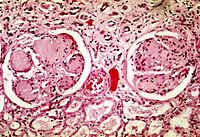
Photo from wikipedia
The authors studied the impact and safety of glucagon-like peptide 1 (GLP-1) receptor agonist therapy in hospitalized diabetes mellitus patients with chronic kidney disease. They found that the use of… Click to show full abstract
The authors studied the impact and safety of glucagon-like peptide 1 (GLP-1) receptor agonist therapy in hospitalized diabetes mellitus patients with chronic kidney disease. They found that the use of GLP-1 receptor agonist therapy had better outcomes in patients with glomerular filtration rate (GFR) stages 3 to 5 as compared with GFR stages 1 and 2; for both GFR groups, there were minimal adverse events. This study suggests that the off-label use of GLP-1 receptor agonists for hospitalized DM patients with chronic kidney disease may be useful. Abstract Objectives The use and overall benefit of glucagon-like peptide-1 (GLP-1) receptor agonist therapy for hospitalized patients with type 2 diabetes mellitus (DM) with chronic kidney disease (CKD) has limited data regarding impact and safety. We studied the impact and safety of GLP-1 receptor agonist therapy in hospitalized DM patients with CKD. Methods Retrospective study of 51 patients using either dulaglutide (n = 3) or liraglutide (n = 48). Glomerular filtration rate (GFR) groups of stages 3 to 5 and 1 and 2 were compared. The primary outcome was total amount of insulin within the last 24 hours in the hospital. The secondary outcomes were glucose management and safety. Results Mean insulin total amount within the last 24 hours in the hospital significantly differed (P = 0.01) between the GFR groups, with the GFR stages 3 to 5 group (mean 0.5, standard deviation 0.36) having a lower mean insulin level than the GFR stages 1 and 2 group (mean 0.8, standard deviation 0.45). Point-of-care glucose reached the target of 140 to 180 mg/dL within the last 24 hours in hospital, with increased odds for the GFR stages 3 to 5 group as compared with the GFR stages 1 and 2 group (odds ratio 4.08, 95% confidence interval 1.05–15.83, P = 0.04). For both GFR groups, there were minimal adverse events. Almost all of them continued GLP-1 receptor agonist therapy at discharge (94.1%). Conclusions The use of GLP-1 receptor agonist therapy had better outcomes in patients with GFR stages 3 to 5 as compared with GFR stages 1 and 2. There were minimal adverse events reported for both GFR groups. This study suggests that the off-label use of GLP-1 receptor agonists for hospitalized DM patients with CKD may be useful.
Journal Title: Southern Medical Journal
Year Published: 2023
Link to full text (if available)
Share on Social Media: Sign Up to like & get
recommendations!